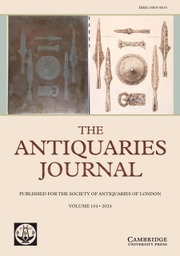The City of London ceased to be an international port in the 1950s and subsequently many archaeological investigations have accompanied the redevelopment of its redundant warehouses and wharves. These investigations have revealed the development of the port facility over the centuries, starting with a Roman quay constructed in the mid-first century ad. The present volume is a ‘sequel’ to a previous one, which covered the development of the port from 1100 to 1666 (Schofield et al Reference Schofield, Blackmore, Pearce and Dyson2018; Schofield Reference Schofield2019); it is based on four waterfront excavations carried out between 1974 and 1984 by the Department of Urban Archaeology (DUA) of the Museum of London.
This volume is concerned with the post-Great Fire development of the port until the construction of downstream facilities, a trend that began with the creation of the West India Dock (opened in 1802). From this period, only two of these four investigations (Seal House and Billingsgate Lorry Park) produced significant structural remains (the foundations of brick-built residential properties), plus associated features such as cesspits and finds assemblages; at a third site, Swan Lane, a single cesspit only was discovered. A few of the associated finds, such as cowrie shells, which were probably intended as trade goods in Africa, represent evidence of participation in commerce. It is noteworthy that the assemblage of associated ceramics from the site of the largest investigation at Billingsgate Lorry Park included only a small percentage of imported continental and oriental wares (Chinese porcelain), which gradually increased over time. The archaeological content of this volume could have been supplemented by a more systematic review of the other relevant archaeological investigations and finds assemblages from the City and its environs, such as the 1982 DUA excavation at Rangoon Street of a significant portion of the foundations of the monumental 1796 East India Company tea and drugs warehouse (Bowler Reference Bowler1983, 17; Evans Reference Evans1990, 646–8).
Interestingly, because of their antiquity, the four waterfront investigations on which this volume and its predecessor are based have now become part of the history of the City’s archaeology. Two of these investigations (Seal House and Swan Lane) consisted of narrow longitudinal trenches intended to sample a tiny percentage of the site sequence, while at New Fresh Wharf the longitudinal trenches were wider. Only one of these investigations (Billingsgate Lorry Park 1982–3) included an open-area excavation (covering less than twenty per cent of the site footprint), so naturally this site revealed the most extensive evidence of post-Great Fire activity. On all four sites, after their partial excavation, the rest of the archaeological deposits were machined out during ground reduction, which was usually monitored by a watching brief. It is worth remembering that prior to 1972 there had been no controlled archaeological excavation of any part of the City’s waterfront, so the fieldwork of the DUA represents a vast improvement on the previous arrangements. Previous fieldwork on the City’s waterfront generally consisted of watching briefs carried out by a single field archaeologist, who attempted to retrieve finds and record deeply stratified archaeological deposits during ground reduction. This volume, like its predecessor, is a great testament to John Schofield’s endeavours over many years, serving as a memorial to the skilled fieldwork that was often carried out in difficult circumstances by small teams of field archaeologists; furthermore, it is a stark reminder that a vast amount the City’s maritime heritage of all periods has been destroyed without record, making what little survives a precious resource.
Because of the limited amount of archaeological data from the four study sites, much of the book is devoted to a detailed and extremely well-illustrated account, based on original documentary research, of the historical development of the port of London during the period under review. It seeks to reconstruct a vanished urban landscape and discusses various related topics such as the material culture of daily life during this period and the City’s involvement in slavery. It is to be hoped that the list of thought-provoking research questions in Chapter 9 will encourage further research on the time when London became the centre of a global maritime empire.


